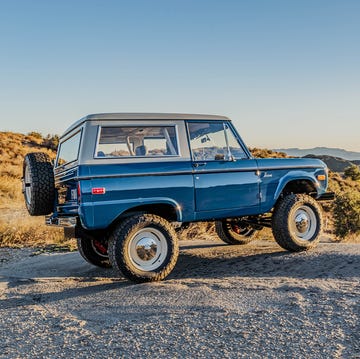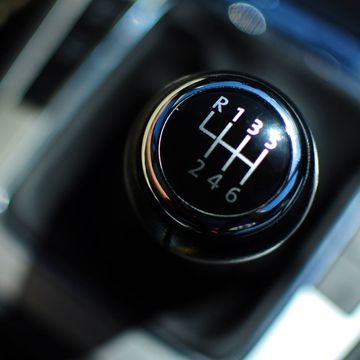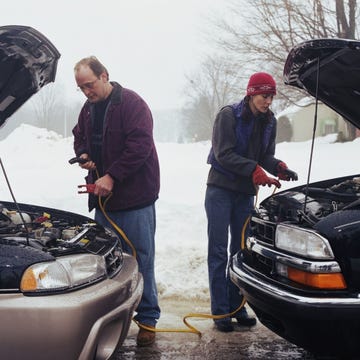I love hot dogs spun to plump, juicy perfection on the roller grill. Add a layer of melted nacho cheese straight out of the dispenser. Make it a meal with a 99-cent bag of Fritos, a fountain soda—half Hi-C orange/half Sprite in a Styrofoam cup—and a King-Size Kit Kat for dessert. That's comfort food to me. That's home. I grew up in a gas station.
My father owned at least one rural central Missouri convenience store—Leroy's Market on Highway 52 and then Leroy's (Highway) 63 Minimart—from the time I was four. My earliest memories were formed under a huge Phillips 66 shield, and many involved running barefoot up and down aisles. My first job was emptying the trash cans by the pumps (as nasty as you think). Eventually I worked my way inside, stocking shelves before graduating to cashier. It was a cushy gig compared to my friends' jobs sweating in the hay fields or busing tables at restaurants in Jefferson City, but I had the tougher boss. My father was always hovering—in case someone wanted to buy a 12-pack of Natural Light (which I was too young to ring up), or in case anything strange appeared on the black-and-white surveillance monitor that was trained on the register.
These shifts were some of the closest hours I've ever spent with my father. "Don't wish minutes of your life away," he'd say when he caught me watching the clock. "Stupid people get old too," he said after an old guy went off on a Red Scare conspiracy rant. I also learned how to take criticism. Every time sweet old Mrs. Snodgrass (actual name) came in for her pint of bourbon, as she dug into her coin purse, she'd mutter, "You know, C&C's gas is a penny cheaper." My dad never said a thing.
It was a common complaint. Nobody cared about the cost of milk or the cash they threw away on dollar scratch-offs. But how dare we mess with the big black numbers on the light-box sign outside? They put my father in an angry knot: If prices were too high, he was greedy; too low and he must be getting rich by pulling in so many cars. My father would smile and nod and say "Thank you" and "Come back soon." "Damned if you do and damned if you don't," he'd say after they left. He appreciated his customers and didn't lecture them on the fact that he didn't actually make his living selling gas.
At the time of this writing, the average gallon of gas costs $2.33. Oil, meanwhile, is selling at $53 a barrel, or $1.26 per gallon. But it's still just oil—and lots of it is in Texas. Add taxes (an average of 50 cents per gallon) and you've bumped it up to $1.76. Refining is about 17 percent of the total cost, so another 40 cents—$2.16. By the time you mix in expenses like delivery and credit-card fees, retailers have an average margin of just 5 cents per gallon.
Our station had to have its three giant tanks—22,000 gallons total—refilled every five days, and you're stuck with whatever that day's rate is. During the intervening days, the price of oil would fluctuate. If he paid $2 per gallon and the price later dropped to $1.90, he was $2,200 poorer—not to mention that it gave his competitors a chance to fill their tanks at a price below his break-even point. A prolonged downturn in prices can make a small retailer sweat.
So why did he bother? Well, gas did turn a profit. And the brightly lit sign did more than give customers something to gripe about—it beckoned them inside the store. Today, filling-station owners make 60 percent of their profits on peanuts and sandwiches and slushies and energy drinks. That's why they go to war over nine-tenths of a cent, and why my father would pinch his margin to a cent or less to beat the competition, grumbling that people would burn a dollar of gas driving to Tuscumbia to save a few pennies.
My father offered amenities, maintaining an in-store deli and installing what I still believe was the biggest and coldest beer cooler in Osage County in the late 1990s. By the 2000s, he had upped his game with roller grills, a pizza oven, and an Icee machine. But when Jefferson City stations started going pay-at-the-pump around 2004—making it easier for drivers to avoid coming inside—my father didn't. "I'm just not going to do it," he said. When our beloved Phillips 66 made pump-side credit-card systems a requirement, he chose to rebrand to the lesser known Cenex. Around the same time, local big-box stores like Costco, Sam's Club, and "goddamn Walmart," which had been taking chunks out of my father's commissary business for decades, got into the gas game. Those giants could afford to skate on the thinnest of profit margins just to attract cars and club members. But in the end, it was the "damn government" and its "damn regulations" that required costly updates to pumps and systems that made my father get out. He retired two years ago at age 65.
I can tell he misses it—he still asks me what prices were at the stations I passed on the way home. I don't really pay attention to the price of gas anymore. Not because I'm rich or anything, but because gas is a necessity and I don't have time to drive around to find a lower number. But everywhere I stop, I go inside, and even if I just use the bathroom, I buy something. A Smartwater. A bag of almonds. Or, if I'm really hungry, a nacho dog, for old time's sake.
Secrets of the Gas Station Revealed!
Insights that will save you drive time (and a few tenths of a penny).
Why is the gas cheaper across the street?
The guy across the street could be locked into a cheaper distribution contract. He might have filled his tanks when prices were down. Or he's squeezing his margin or even taking a loss to divert customers from the competition.
Why is gas priced to nine-tenths of a cent?
Eighty years ago, a penny bump in price was a significant hike, so retailers raised prices by fractions of a cent. It's a leftover tradition that's become pure marketing: $2.29 9/10 looks more inviting than $2.30.
Do run-down, no-name stations sell bad gas?
The lack of, say, a Phillips 66 sign out front only means the station isn't contracted to sell that brand's gas. Depending on prices, it may be selling it, and if not, it's pumping unbranded—but still EPA-approved—fuel. Truly bad gas is rare: Most states inspect at random and often.
If there's a plastic bag on one pump handle, should I avoid the station entirely?
Quite the opposite: Bagged pumps have been inspected by the state and found to be inaccurate. Which means unbagged pumps are spot-on, so you can be confident you'll get what you pay for.
This story appears in the July/August 2017 issue.













